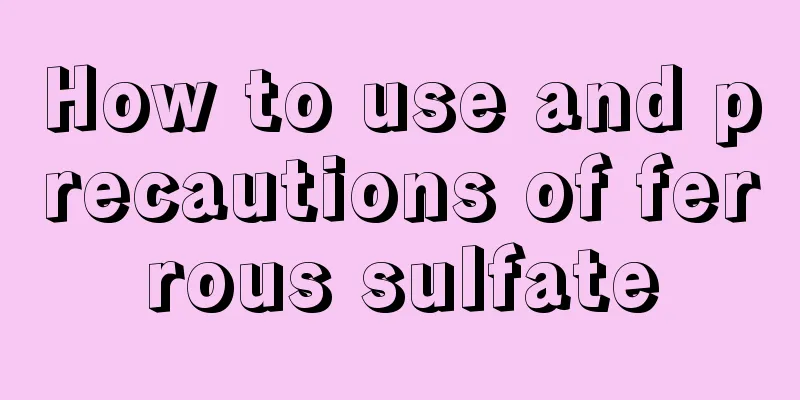How to use and precautions of ferrous sulfate

|
Ferrous sulfate is almost an essential maintenance fertilizer for flowering plants. It can not only adjust the acid-base balance of the soil, but also make the leaves of many plants gradually turn green and reduce yellowing. So how should ferrous sulfate be used? What are the precautions? Let’s learn more about it below. 1. Preparation method You can buy ferrous sulfate fertilizer specially for flowers in the flower market and mix it with water at a concentration of 0.2%-0.3% to make a solution. That is, take 10g of ferrous sulfate, add 4L-5L of water, mix well and use. 2. Applicable plants Ferrous sulfate is suitable for flowers and trees that prefer acidic soil, such as camellia, azalea, gardenia , etc. 3. Usage (1) Root application: dissolve ferrous sulfate in fertilizer water or clean water and directly water the flowers and trees. The concentration of the solution can be controlled at around 2%. Alternatively, you can also place ferrous sulfate directly on the surface soil of the flower pot, and wait for it to gradually penetrate and absorb when watering. (2) Foliar fertilization: Ferrous sulfate can be dissolved in water and applied to the stems and leaves using a sprayer. It will be absorbed through the air pores on the leaf surface and directly act as a fertilizer. When spraying, it is best to do it in the morning or evening on a windless day. It can also be used together with urea for better results. 4. Notes (1) Use in moderation: Do not use ferrous sulfate in excess. Excessive use will cause black spots on the surface of plant leaves, accelerate yellowing and leaf fall, and even cause severe soil acidification. It is usually recommended to dilute ferrous sulfate into aqueous solution at a ratio of 1:1000. (2) Prepare and use immediately: Do not leave the ferrous sulfate solution for too long, as ferrous sulfate is easily oxidized by oxygen in the air. So it is best to dilute the dosage once to ensure it works at its best. (3) Use alone: Ferrous sulfate easily reacts with elements such as calcium and magnesium, so it should be used alone when growing flowers. (4) Avoid using with alkaline flowers: Ferrous sulfate is suitable for acid-loving flowers, but it is best not to use it with alkaline flowers. When preparing ferrous sulfate solution, try not to use alkaline water to prevent acid-base neutralization from affecting the fertilizer effect. In addition, if there is no ferrous sulfate at home, you can temporarily use vitamin C or white vinegar instead. The best white vinegar is brewed white vinegar, while red vinegar cannot be used for a long time because it contains salt. In general, ferrous sulfate is a commonly used gardening product, mainly used to adjust soil pH and supplement the iron needed for plant growth. However, you must be familiar with its usage and precautions in advance to avoid adverse effects.
|
<<: Is Phalaenopsis suitable for indoor cultivation? How to maintain it well?
>>: Can trumpet creeper be planted in autumn? How to plant it?
Recommend
How to grow passion fruit at home? What to do if the leaves wilt in the sun?
1. Domestication Method 1. Soil: Passion fruit ha...
How to grow succulents
1. Plant in time If you have just bought the plan...
Cutting propagation method of forked-leaf sundew
Time Cutting propagation of Drosera forkleaf can ...
How to make green beans sprout quickly
Green bean germination environment When caring fo...
How to grow chives so that they bloom
Flowering time of leek Allium can bloom in spring...
The cultivation methods and precautions of thread iron
A breeding method 1. Potting soil: Because it is ...
Cucumber's growing environment and local conditions
Cucumber Growth Environment and Conditions Cucumb...
How to take care of the newly bought lucky tree
1. How to take care of the lucky tree you just bo...
How to grow clematis
1. Soil Clematis prefers relatively fertile weakl...
What fertilizer is suitable for tomatoes?
Tomato fertilization time The main method of fert...
When is the best time to prune mulberry leaf peony?
Overview of Peony Mulberry leaf peony, also known...
How to grow Houttuynia cordata at home? Is Houttuynia cordata poisonous?
1. How to raise 1. Suitable light: Although Houtt...
When is the best time to plant onions (how to plant onions for high yield)
Onion is a perennial herb of the genus Allium and...
What fertilizer is best for peppers?
There are many farmers who grow peppers , but the...
What fertilizer is best for Polygonatum sibiricum
Fertilization time Polygonatum sibiricum requires...









